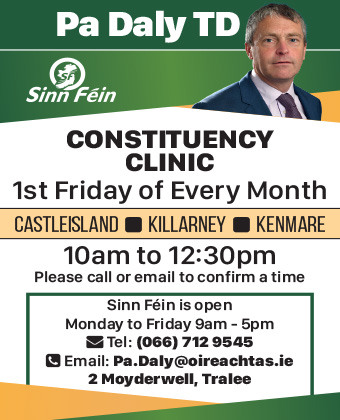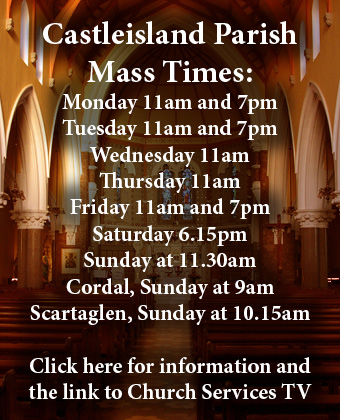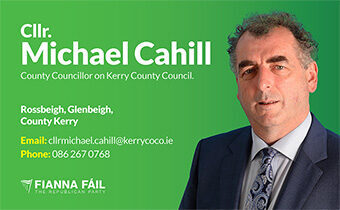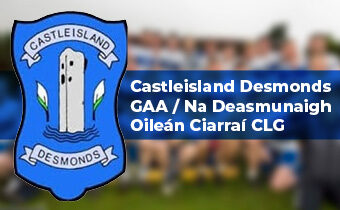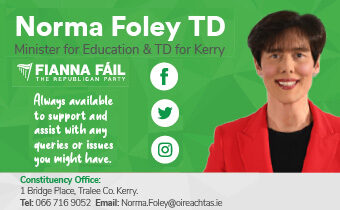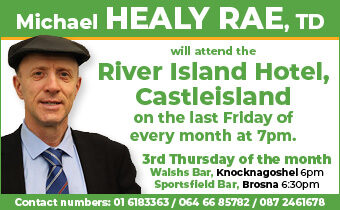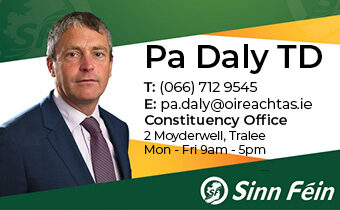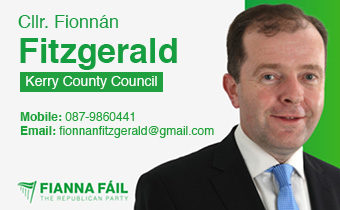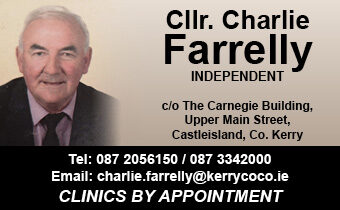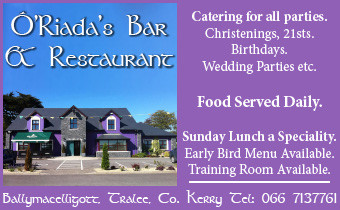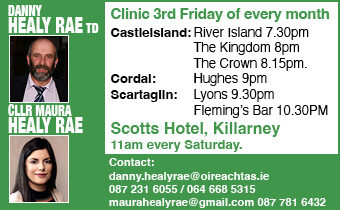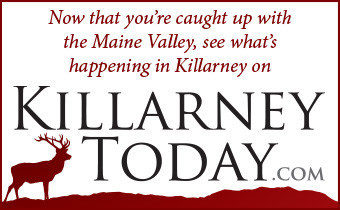

Tributes were paid and wreaths laid in memory of Richard Shanahan, Castleisland; Jack Prendiville, Cordal and Jack Flynn, Gortatlea on the centenary of their deaths in a gun battle with British forces on curfew patrol in Castleisland on Sunday evening of July 10th. 1921.
There were two separate but intertwining ceremonies in Castleisland on Saturday evening to mark the ultimate sacrifice made by the three men and their comrades and all who died in the locality in the fight for freedom.
The Castleisland Sinn Féin Cumann organised the first of the two at 7pm at the monument and a colour party opened the proceedings with a short march from the old library to the monument on Rice’s Height on the Cordal Road.
Wreaths Laid by Relatives
Cuman founder member, Kate McSweeney chaired the event and wreaths were laid by relatives of the men and Sinn Féin TD for Kerry Pa Daly was the invited speaker.
Teachta Daly opened his address by giving some background details on the three men who died on that evening 100 years ago.
Richard Shanahan
Richard Shanahan was born in 1902 at 45 Main Street, Castleisland.
His family ran a successful business in the town. Richard, or Dick as he was known, was a member of the Castleisland Company of the 1st Battalion, Kerry No. 2 Brigade.
He was an active Volunteer from the outset of the war and when the Kerry No. 2 Brigade was revamped, he was appointed adjutant of the 1st Battalion.
Despite the large military and police presence in the area, the 1st Battalion made it particularly hostile for crown forces.
Richard’s brother Jack had been severely injured in a military raid in Farranfore in May 1921.
Jack Flynn
Born in 1893, John (Jack) Flynn was a native of Gurranemore, Gortatlea.
Jack was a member of the Ballymacelligott Company and had participated in raids at Gortatlea and Scartaglin RIC Barracks.
He was involved from the beginning of the ‘Tan war’ and was sadly killed on the eve of the truce that would end the conflict.
Jack had been active the entire way through the war and, at the time of his death, was a Lieutenant in the Ballymacelligott Company. Fuair sé bás dhá lá roimh a bhreithlá – before his 28th birthday.
John (Jack) Prendiville
John (Jack) Prendiville was born in 1899 from Breahig, between Cordal and Scartaglin.
Jack was a Volunteer in the very active Company of the 1st Battalion, Kerry No. 2 Brigade.
From the initial attack in April 1918 at the Gortatlea RIC Barracks, the Ballymac Company and the Cordal Volunteers forged close links, and formed the basis of an active unit which made Castleisland such a challenge for crown forces.
Jack, along with his brother Denis ‘Den’ took part in numerous actions and had many close calls with death and capture. Denis also participated in the Castleisland ambush but was in a position to withdraw on that occasion.
Orders from Humphrey Murphy
The day before the cessation of arms was due to take place, Brigade O/C Humphrey Murphy gave orders for an ambush on 15- 20 soldiers of the Loyal North Lancashire Regiment on a curfew patrol of the town.
While up to sixty Volunteers had gathered to take part, word was sent around that the patrol would not happen and many left.
So a smaller group of 30 Volunteers were present when they were informed that the patrol would go ahead. There was a ferocious firefight and many Volunteers dispersed or were separated.
It was usual for a patrol to leave the Barracks at the southern side of the town and parade up Main Street.
The Brigade O/C. fixed the attack for the night of July 10th 1921. Denis took up position in a laneway at St. Stephen’s Church with Michael O’Leary and Jack Barrett. Other parties were posted in laneways on both sides of Main Street.
As Den Prendiville recalled later in the military archive, the brigade and battalion staffs took up positions in the ruins of the Library – which they had burned the previous month as it presented a strategic lookout post for the British.
“The men in the Library ruins included: Humphrey Murphy, Brigade O/C., Thomas Daly, Jerry O’Leary, David McCarthy, and Con O’Leary.
The patrol came out of the Barracks as usual and proceeded up the Main Street. When they got to the Limerick Road they came under fire. A general fight developed.
The party in the Library ruins opened fire down the Main Street. My party opened fire out of the lane-way on a party which had left the Barracks to reinforce the patrol.
While some of the British Military held us the remainder returned to the Barracks and passing through left the Barracks by the rear, on both sides of the town.
My party started retiring towards the north of the town along the backs of the houses fighting as we went. All parties on the west side of the town retired while my party covered them.
My party then withdrew under heavy machine gun fire. Our men on the west side of the town found themselves being surrounded and commenced to retreat, but ran into difficulties (trapped in a quarry) when a machine gun was brought into play against them – three (my brother Jack Prendiville, Dick Shanahan and Jack Flynn) being killed in a hail of bullets before the party could finally withdraw.
The British lost six killed out of the original patrol.”
Amhrán na bhFiann
The ceremony was ended with the singing of Amhrán na bhFiann and Chairperson McSweeney reminded the gathering that Eamonn Breen’s walk and talk commemoration was about to start down at the old library at the fast approaching hour of 8pm.
A murder of crows took up spaces on the ridge-tiles of the historic old library as Piper Noel O’Mahony warmed up his instrument and event chairman and Cordal man, Tommy O’Connor welcomed the gathering.
100 Year Old Flags
As the event itself unfurled a century old, but very live and local history, flags were unfurled that were used to accompany the bodies of the dead volunteers as part of their funeral cortège to Kilbanivane this week 100 years ago.
The flags are in the safe keeping of Castleisland native and Dublin resident Eileen Geaney – a grand-niece of Richard Shanahan.
Proudly carrying one of the flags was Margaret Geaney – a niece of Richard’s and a daughter of Jack Shanahan’s – along with his grandson and local pharmacist, Jack Shanahan. Margaret’s son Dave took over on the homeward lap.
History in Every Stride
Young Noreen Prendiville, a grand-niece of Jack Prendiville, with mom Mary stepped up to take the long banner on the parade with Aaron Shanahan-O’Mahony and his mom Catherine Cate Shanahan – a grandniece of Richard.
The parade of up to 60 people of all ages left the top of the town for the Old Chapel Lane / Ivy Leaf Corner and Eamon Breen, with the aid of a loudspeaker, narrated the journey down along the street with history in every stride.
Tricolour Blew Gently
The parade turned there and headed back up town towards the library and veered off into the Castleisland Rugby Club grounds where some of the fiercest fighting took place on that fateful night.
A tricolour blew gently in the balmy, misty evening from Martin Curtin’s Shop where the aforementioned Den Prendiville lived.
The event ended at the monument with guest speakers, Martin Moore and Dr. Tim Horgan and the always tuneful Noel O’Mahony brough his pipes into play with Amhrán na bhFiann.
The following is Dr. Horgan’s speech on the occasion:
Castleisland Centenary Oration
By: Dr. Tim Horgan
The past is not dead, it is not even past. The ‘wise men’ have told us that it all happened long ago and is now best forgotten and, if it must be recalled at all, it is more ‘mature’ to do it in their prescribed, all-inclusive manner.
But we in Kerry do not agree – to us the past is important and it defines who we are as we move on to an always uncertain future.
What Is Important and What Is Not
The past tells what is important and what is not, what is worth living for and what is worth dying for, and tells us that there is a difference between these three selfless Irish soldiers who had no price and those colonised Irishmen who could be easily purchased.
So great was their idealism and their dedication to that cause that patriots such as Richard Shanahan, Jack Flynn and Jack Prendiville do not belong in the past.
When actions and not words were required, they acted, regardless of the personal consequences.
An Example For Today
They belong to the present, and to the future, their legacy being an example for today and a guide for tomorrow.
As so we come together here this evening where great men fell fighting for the freedom, the total freedom, of our country. We gather not because we were summoned, not to be seen, not to garner votes, not for a photo opportunity, but because we should – we gather because it is our duty to remember Jack Flynn, Richard Shanahan and Jack Prendiville such is the debt we owe them.
Belittled, Disregarded and Forgotten
We have been told that our history will make others feel uncomfortable; That it might be better to consign those who paid for our liberty to the national amnesia, that Alzheimer’s of the political elite where the past, its beliefs, its culture, our Christian traditions and our heroic history are all to be belittled, disregarded and forgotten.
But by your presence here today, we acknowledge that those whom we honour did not endure death so that we, as a nation, might shrink back in order to make somebody else feel more comfortable.
Be Proud in Remembering
The ideals of those Irish men who gathered here a century ago should be our nation’s creed, their deeds our country’s song, we should be loud, we should be proud in remembering our heroic past.
The manicured history we are given today suggests that Michael Collins and Eamon DeValera almost single-handedly drove the British from Ireland – Ireland of course being defined as 26 counties and not the national territory of the 1916 proclamation.
However, Eamon DeValera never fired a shot at the enemy and the only gun fired in anger by Michael Collins was in the minutes before he died in 1922.
War Against the British
Those who actually won our liberty, or such of it that we have, were the men who fought in the fields and ditches of Ballymac, Cordal, Scartaglin and Currow, in the lanes of our small towns, on Castleisland’s Main Street.
The war against the British began in Gortatlea in 1918 when Jack Flynn and his six ill-armed comrades confronted the forces of the Crown.
Three years later, better armed, he and over thirty other battle-hardened comrades, bravely confronted Britain’s army on the final day of that war. When the firing ceased, Jack Flynn lay dead beside Richard Shanahan and Jack Prendiville.
Ambitions Achieved
Unlike that of the five British soldiers who also died that evening, the three volunteers deaths had not been in vain, their short lives’ ambition had been achieved. Irishmen and women could walk along Castleisland’s streets again as a free people for the first time in eight hundred years.
This they did in their thousands three days later as they followed the three tricoloured draped coffins of the men who paid for that freedom.
It is not by chance that we gather here on Castleisland’s main thoroughfare for on this street the history of Ireland could be written.
Tyrannical Landlords Harried
The Earl of Desmond made his final stand in the hills overlooking us. In 1798, heads of our patriots were placed on British pikes at the other end of the street, Whiteboys harried tyrannical landlords, Bob Finn and his Fenians conspired and the Moonlighters acted in defence of their people’s rights during the Land War in which the Shanahan family were prominent. Poff, Barrett and Twiss walked this street, Dan O’Mahony and his comrades of 1916 passed along this way.
Castleisland – The Crossmaglen of Kerry
In the Black and Tan war, Castleisland was the Crossmaglen of Kerry and during the Civil War the blood of patriots was spilled on this street.
The torch of history, that flame of freedom, has been handed down here in Castleisland from generation to generation, and from century to century, and your presence here tonight ensures that the spirit that brought this three patriots to their deaths on this spot will not be allowed to fade.
For a hundred years, people have come to this site. Sometimes in large parades, often in small groups, frequently in ones and two, but always there were those who would not forget even when remembrance was frowned upon and commemoration deemed a crime.
Heads Bent in Respect
Flowers would be laid, heads bent in respect and silent prayers said by your people, many of whom have long passed.
The sacrifice of these patriots was committed to stone in the monument, in Kilbanivane graveyard and on the Ballyseedy memorial and such memorials proudly cared for.
For this we are grateful to you who came and cared; to the many long dead who would not let us, let Castleisland, let Ireland forget – great men died here for liberty.
The Price of Our Freedom
Freedom is never for free, these men have paid the price that you might be free.
It might come as a surprise to those who seek to guide the commemoration by the Irish people of our past, but there is a difference between those who fought for liberty and those who were paid to kill so that the flame of freedom would be quenched, there is a moral difference between those who defended their land and those who served a foreign empire, there is a difference between those who fought for the Irish Republic and those who sought to suppress it.
Here on this street one hundred years ago, there was a difference between our three dead patriots and those who gunned them down.
Unfettered By Foreign Occupation
This difference may be lost on a Taoiseach as he wears a poppy in Fermanagh to commemorate the gun men of the empire.
It may be lost on those academics who would seek to revise your history or to those journalists who would distort your nation’s past.
Jack Prendiville, Jack Flynn and Richard Shanahan died not for any political party but for Ireland, for a totally independent Ireland, unfettered by foreign occupation.
Enough To Know They Dreamed
They died for their people, for their community and so it is fitting that they are remembered here by that community, regardless of anybody’s present day political affiliations.
To quote WB Yeats, “we know their dream; enough to know they dreamed and are dead”.
Their dream may have become an embarrassment to many of today’s politicians in their search for a royal handshake or approval from our former colonial masters.
But we know their dream and though they are dead that dream will not be allowed to die.
History has always spoken a different language than that the laws which condemn Irish men who fight for Ireland’s freedom.
However, that history and the hopes of our patriot dead have yet to rhyme.
Castleisland Remembers, Kerry Remembers
The past is not dead and thanks to you gathered here today, it lives on as it should, so that that future generations will know that three heroic men sacrificed everything for liberty.
Jack Flynn, Richard Shanahan and Jack Prendiville died on this spot for Ireland’s freedom, for your freedom, one hundred years ago.
Castleisland remembers, Kerry remembers, and Ireland will not be allowed to forget.
Dr. Tim Horgan is a Tralee based author and historian.
 You can contact The Maine Valley Post on…Anyone in The Maine Valley Post catchment area who would like to send us news and captioned photographs for inclusion can send them to: jreidy@mainevalleypost.com Queries about advertising and any other matters regarding The Maine Valley Post can also be sent to that address or just ring: 087 23 59 467.
You can contact The Maine Valley Post on…Anyone in The Maine Valley Post catchment area who would like to send us news and captioned photographs for inclusion can send them to: jreidy@mainevalleypost.com Queries about advertising and any other matters regarding The Maine Valley Post can also be sent to that address or just ring: 087 23 59 467.












